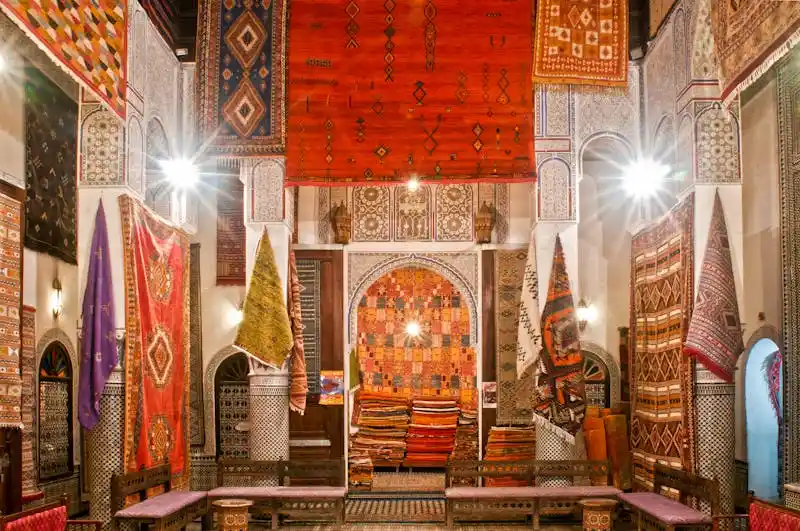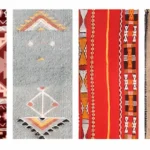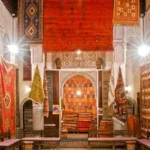Introduction
Carpets and rugs constitute vital components of human lifestyle that span thousands of years in human civilization. Twined virtuosities functioned as practical items and aesthetic representations and cultural identifiers for the Central Asian nomadic groups and Persian palace buildings in addition to European aristocratic homes.
What are the historical steps that carpets and rugs went through with changing times? The first creators of sophisticated crafting methods remain unknown. Through what process have carpets transformed interior design traditions throughout various cultures?
In this article, we’ll explore:
- The origins of carpets and rugs and their earliest uses
- Throughout history the different civilizations developed their weaving techniques
- Carpets developed into elegant items which gained status alongside luxury holdings.
- The influence of Persian, Oriental, and European rug-making traditions
- The modern advancements in carpet production
You will achieve a better comprehension of carpets and rugs historical development and their everlasting cultural value when you finish reading.
Table of Contents
1. The Origins of Carpets and Rugs
1.1 The Oldest Known Rug: The Pazyryk Carpet
The Pazyryk Carpet from 1949 represents the oldest surviving handmade carpet ever discovered in a Siberian burial site. Proof of advanced carpet art from antiquity emerges through the 5th century BCE Pazyryk exhibition which displayed intricate stitching with deep coloring and complex weaving patterns.
Major aspects regarding the Pazyryk Carpet include the following important points:
- Found in the tomb of a Scythian prince in Siberia.
- The Pazyryk Carpet exists since a period exceeding 2,500 years.
- The craftsmen created this carpet by manually knotting its patterns into symmetrical designs while using vibrant dyes.
Fun Fact: Today the Pazyryk Carpet rests permanently at the Hermitage Museum within the city of St. Petersburg, Russia.
1.2 Early Uses of Carpets and Rugs
During ancient times rugs had dual purposes as protective elements and interior furnishings alongside retaining cultural identification.
- Nomadic Tribes: Nomadic tribes incorporated rugs into their tents to serve purposes of insulation and tent bedding as well as providing tent heat through their use.
- Ancient Persia & Mesopotamia: Wove rugs as luxury items for royal courts.
- China & the Silk Road: Exchanged exquisite silk carpets in trade.
- Ancient Egypt: The ancient Egyptians in their temples and their tombs incorporated woven mats and rugs.
Carpets functioned beyond surface floor coverings because they demonstrated tales and presented spiritual imagery and acted as status indicators.
2. The Golden Age of Carpet Weaving (7th-17th Century)
2.1 Persian Carpets: The Pinnacle of Craftsmanship
The international recognition of Persian carpets as the best carpets worldwide exists because of their dense knotting technique and elaborate floral motifs and expensive materials.
Key Persian Carpet Facts:
- Introduced during the Sassanian Empire (224-651 CE)
- Became globally famous under the Safavid Dynasty (16th century)
- Known for their rich colors, natural dyes, and hand-knotting techniques
Famous Persian Rugs
The Ardabil Carpet from the 16th century ranks among the most precious Persian rugs that exhibits at the Victoria and Albert Museum in London today.
Tabriz and Kashan rugs found their names in the historic weaving centers while depicting floral medallion and hunting motifs.
2.2 Oriental Carpets: The Art of the East
The production regions of oriental rugs include Turkey, India, China and Central Asia which resulted in different stylistic expressions.
Turkish Rugs (Anatolian Rugs): Known for bold geometric patterns and rich reds and blues.
Chinese Silk Carpets: Chinese Silk Carpets portrayed delicate dragons together with lotus flowers and Buddhist symbols during their production.
Indian Mughal Rugs: The Mughal Court of India produced oriental rugs based on Persian patterns that featured both gold and silver weaving threads for kings and queens.
The Impact of the Silk Road
The Silk Road trade path united the regions of the Middle East and China as well as Europe while it transmitted carpet craft processes through large distances.
Did you know? In the 15th-17th centuries European rulers used Turkish and Persian rugs to demonstrate their power and social position through importations.
3. European Influence and the Industrial Revolution
3.1 European Carpet Making (17th-19th Century)
European monarchs initiated the replication of Persian and Oriental rugs when international trade increased.
France(Aubusson & Savonnerie Carpets): Aubusson and Savonnerie Carpets from France received orders from Louis XIV to create baroque floral motifs for Versailles.
England (Axminster & Wilton Carpets): Known for hand-knotted wool rugs that decorated aristocratic homes.
3.2 The Industrial Revolution and Machine-Made Carpets
The production of carpets underwent fundamental changes because of new weaving innovations during the nineteenth century.
The First Carpet Loom(1780s): During the 1780s Edmond Cartwright introduced the First Carpet Loom that mechanized carpet weaving operations.
Wilton & Axminster Factories: Produced high-quality, mass-produced carpets for a growing middle class.
Impact: Handwoven carpets shifted from being luxury exclusives to luxury items that came with soaring prices yet machine-made carpets expanded their market to regular home buyers.
4. Modern Carpet Trends and Innovations
4.1 The Rise of Synthetic Carpets
Synthetic materials represented the dominant change during the 20th century leading to the development of carpets by using nylon and polyester as well as polypropylene.
- More affordable
- Easier to clean
- More durable for high-traffic areas
4.2 Sustainable and Eco-Friendly Carpets
The environmental consciousness of customers has led carpet manufacturers to concentrate on developing carpets from natural biodegradable materials including:
Wool – Renewable and naturally stain-resistant
Bamboo & Jute – Eco-friendly alternatives
Recycled Fibers – Made from old carpets and plastic bottles
Today’s Trends: Custom-made rugs have become popular once again as consumers prefer both unique sustainable living designs for their homes.
5. FAQs About the History of Carpets and Rugs
Q1: Where were the first carpets and rugs made?
The earliest known carpets were made in Central Asia, Persia, and Mesopotamia, with the oldest surviving rug being the Pazyryk Carpet (5th century BCE).
Q2: What is the most expensive rug ever sold?
A 17th-century Persian carpet was sold for $33 million at Sotheby’s in 2013, making it the most expensive rug ever auctioned.
Q3: How did carpets spread to Europe?
The Silk Road trade and Ottoman Empire influence introduced Persian and Turkish rugs to European nobility in the 15th century.
Q4: Why were rugs important to nomadic tribes?
Nomadic tribes used rugs for insulation, bedding, and portable flooring, as well as a way to showcase their artistic heritage.
Q5: Are handmade rugs better than machine-made rugs?
Yes! Handmade rugs are more durable, unique, and increase in value over time, while machine-made rugs are mass-produced and have a shorter lifespan.
Difference between rugs and carpets?
Rugs are smaller, movable floor coverings that don’t cover the entire floor. Carpets are larger, often wall-to-wall, and permanently installed. Rugs can be layered over carpets or hard floors for added decor.
Conclusion
Carpets and rugs have survived through centuries despite their original use as decor and evolved into emblematic works of art combining cultural significance and skilled craftsmanship.
Looking for high-quality rugs? Experience the historic collection of CarpetsHub.com to find a piece you can take home.



